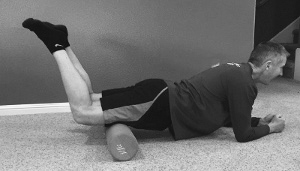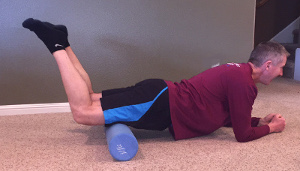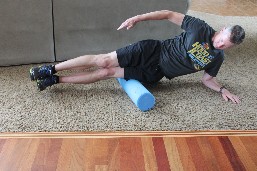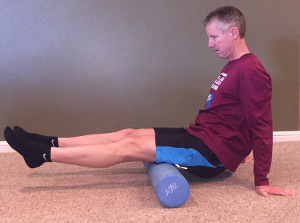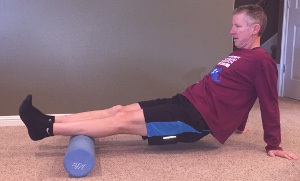American marathon runner Dan Lyne examines the benefits of foam rollers as well as the risks, and highlights four key areas of the body to roll.
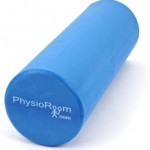
Injury avoidance during marathon training is one of the top challenges for most runners. Strength training, stretching, diet, sleep and proper footwear are the most common ways to stay healthy. However, a foam roller isˡnother tool many runners are aware of, but donִ often use, because they simply arenִ familiar with˩t. When used after post-run stretching, a foam roller can help relieve muscle tightness and keep your muscles strong week after week. This article reviews why a foam roller works, foam roller exercises to avoid and the best basic exercises to integrate into your long distance training regime.
A recent journal Medicine & Science study confirmed the positive effect of foam rolling on athletic performance [1]. Foam rolling improves the mobility of the facia. For us non-medical types, facia is the layer of connective tissue that surrounds the muscles in your body. Without proper mobility of your facia, the fibers within it can attach to muscles and inhibit normal motion which can result in pain. The more flexible your muscles are within their normal range of motion, the more power they will be able to produce. In theory, the more stretch a muscle gets, the more stored energy it has and the more force it will be able to generate. Using a foam roller can result in decreased muscle pain, increased circulation and improved mobility for peak performance. In my experience, using a foam roller as part of your half or full marathon training can help you become a stronger, faster and less injury-prone runner.
How˯ften should you foam roll?
I recommend using a foam roller about three times per week. However, as your mileage increases during marathon training, the frequency of use depends on your body. If you are a flexible runner who doesnִ experience much muscular tightness, thereֳ little benefit in completing regular sessions with a foam roller. However, runners who have persistent tight areas and are regularly stretching for relief may benefit from up to five days a week of foam roller work. Usually, my foam rolling sessions take about seven to 10 minutes. The key to successful foam rolling is to relax, breathe and never rush through the routine.
Foam rolling mistakes
Be careful with too much use of a foam roller to relieve tightness. As with any injury or pain that persists, you should ask yourself why you are feeling this discomfort (in particular, why does the area remain tight) and what could be taking it so long to release. Sometimes continued muscle tightness may be caused by a weakness or problem in some other area of the body. Continued foam rolling may aggravate the problem further.
Don’t roll directly on an injured area. Constantly working the area of pain can result in more tension in the affected area. Also, itֳ possible that the area where you feel pain may not be the source of the injury. For example, I’ve had pain in my lower back that was a result of tightness in my quads. Iֶe also seen this with younger runners. The remedy was a combination of rest, dynamic stretching after workouts and foam rolling.
Avoid foam rolling too quickly. Although it may feel better to go fast because you are circulating some blood flow, foam rolling works best when you work back and forth slowly.
Avoid rolling over bones or joints. Foam rolling is supposed to be a soft tissue exercise. Do your best to distinguish between soreness after workout and an injury. Although rolling over soreness can provide relief by increasing blood flow and faster healing, itֳ also possible that you could further irritate an injury if you stay on the same spot for too long. Staying on one spot for too long can cause damage to the tissue and bruising. I recommend a gentle approach. Start with only half of your body weight on the foam roller by using your hands to adjust the pressure. You can slowly take off pressure and work your full body weight into the roller.
What are the most important areas to roll?
Quads
Lie on your stomach with a foam roller under the front of your thigh and slowly roll back and forth from the bottom of your hip to the top of your knee.
IT Band
Warning, this exercise can be painful.
Tight IT bands are typically the reason runners avoid foam rollers. But I can speak from experience; loosening my IT band has alleviated a lot of discomfort in my lower leg and along my ankle.
The IT band runs alongside your leg from your knee up to the bottom of your hip. When completing this exercise in the beginning, I recommend using your arms to take away some weight off the roller. Lie on your side and roll from just below your hip down to above your knee. Repeat this movement about four times at first and then work your way up to eight times over the next month.
Hamstrings
With the foam roller under your thighs, roll from the knees up to the glutes. You can increase pressure by rolling one leg at a time.
Calves
Place the roller under your calf and rest your other foot on the floor. Roll from the ankle up to just below the knee. Be careful if you have Achilles tendon discomfort. You will irritate – and potentially worsen – Achilles injuries by foam rolling. Rotate your leg both inside and out to get the entire calf muscle. Remember, your muscles arenִ flat, you must roll around them for the full effect. Try putting one over the other to add pressure.
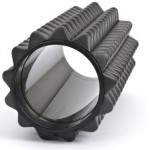
What type of foam roller is best?
PhysioRoom.com offers a wide selection of foam rollers. My advice is donִ go cheap. If you plan on using your roller quite often, you should purchase a roller that is made of black dense styrofoam. This type of foam is highly durable and will last you much longer than a white or light colored foam roller. Some people like the knobs and bumps on a roller. I prefer a smooth roller. The dense foam rollers work the best and last longest.
When should you replace your foam roller?
If the foam is degrading, you should replace your roller because it will no longer have the same effect at releasing tension. Look to see if thereֳ any sagging in the middle of the roller. If you see white specks coming through the black on a black roller, then you should replace the roller.
References:
[1] http://www.ncbi.nlm.nih.gov/pubmed/24343353 РFoam rolling as a recovery tool after an intense bout of physical activity. Macdonald GZ, Button DC, Drinkwater EJ, Behm DG.
Disclaimer: The content in this article is based on the authorֳ personal experience and thorough personal studies. The information provided here is designed to help you make informed decisions about your health. It is not intended as a substitute for any treatment that may have been prescribed by your doctor or physical therapist. All forms of exercise pose some inherent risks. The author advises readers to take full responsibility for their safety and know their limits. There is no guarantee that you will experience the same results and benefits as presented, and you accept that the risk that the results can differ by individual.
Dan Lyne is a long distance runner from Camas, WA. With over 36 years of running experience, he specialises in coaching long distance runners and helping them achieve their half and full marathon goals through his website, middleagemarathoner.com.


